Navigation
Millennium Development Goal Drinking Water Target Met in Advance of Deadline
The world has met the Millennium Development Goal (MDG) target of halving the proportion of people without access to safe drinking water, well in advance of the MDG 2015 deadline, according to a report issued on March 6, 2012 by UNICEF and the World Health Organization (WHO). Between 1990 and 2010, over two billion people gained access to improved drinking water sources, such as piped supplies and protected wells.
Goal 7, target 7c of the Millennium Development Goals aims
at halving by 2015 the proportion of people without sustainable
access to safe drinking water and basic sanitation
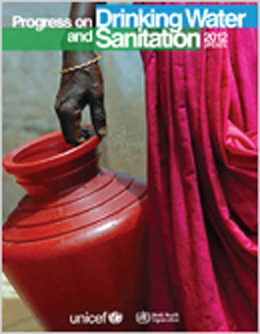 Progress on Drinking Water and Sanitation 2012: In this new report UNICEF and partners announce reaching the Millennium Development Goal target of halving the proportion of people without access to safe drinking water, well in advance of the 2015 deadline.The world has met the Millennium Development Goal (MDG) target of halving the proportion of people without access to safe drinking water, well in advance of the MDG 2015 deadline, according to a report issued on March 6, 2012 by UNICEF and the World Health Organization (WHO). Between 1990 and 2010, over two billion people gained access to improved drinking water sources, such as piped supplies and protected wells.
Progress on Drinking Water and Sanitation 2012: In this new report UNICEF and partners announce reaching the Millennium Development Goal target of halving the proportion of people without access to safe drinking water, well in advance of the 2015 deadline.The world has met the Millennium Development Goal (MDG) target of halving the proportion of people without access to safe drinking water, well in advance of the MDG 2015 deadline, according to a report issued on March 6, 2012 by UNICEF and the World Health Organization (WHO). Between 1990 and 2010, over two billion people gained access to improved drinking water sources, such as piped supplies and protected wells.
United Nations Secretary-General Ban Ki-moon said, “Today we recognize a great achievement for the people of the world. This is one of the first MDG targets to be met. The successful efforts to provide greater access to drinking water are a testament to all who see the MDGs not as a dream, but as a vital tool for improving the lives of millions of the poorest people.”
The report, Progress on Drinking Water and Sanitation 2012, by the WHO/UNICEF Joint Monitoring Programme for Water Supply and Sanitation, says at the end of 2010 89 per cent of the world’s population, or 6.1 billion people, used improved drinking water sources.
This is one per cent more than the 88 per cent MDG target. The report estimates that by 2015 92 per cent of the global population will have access to improved drinking water.
“For children this is especially good news,” said UNICEF Executive Director Anthony Lake.
“Every day more than 3,000 children die from diarrhoeal diseases. Achieving this goal will go a long way to saving children’s lives.”
Sanitation target still lagging far behind
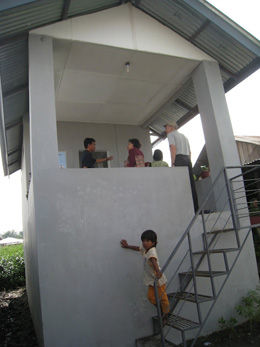 Communal wash facilities/toilets in a flood plain of peri-urban Medan, Indonesia.: Photograph courtesy of Jay Graham
Communal wash facilities/toilets in a flood plain of peri-urban Medan, Indonesia.: Photograph courtesy of Jay Graham
Lake warned that victory could not yet be declared as at least 11 per cent of the world’s population – 783 million people – are still without access to safe drinking water, and billions without sanitation facilities.
“The numbers are still staggering,” he said. “But the progress announced today is proof that MDG targets can be met with the will, the effort and the funds.”
The report highlights, however, that the world is still far from meeting the MDG target for sanitation, and is unlikely to do so by 2015.
Only 63 per cent of the world now have improved sanitation access, a figure projected to increase only to 67 per cent by 2015, well below the 75 per cent aim in the MDGs.
Currently 2.5 billion people still lack improved sanitation.
UNICEF and WHO also cautioned that since the measurement of water quality is not possible globally, progress towards the MDG target of safe drinking water is measured through gathering data on the use of improved drinking water sources. Significant work must be done to ensure that improved sources of water are and remain safe.
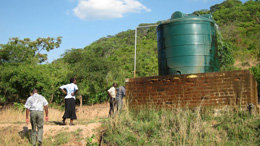 Gravity fed water system connected to a local spring: in Kaombe village (Mpika district) from images on Water, sanitation and hygiene in Zambian schools, photograph courtesy of Jay Graham
Gravity fed water system connected to a local spring: in Kaombe village (Mpika district) from images on Water, sanitation and hygiene in Zambian schools, photograph courtesy of Jay Graham
“Providing sustainable access to improved drinking water sources is one of the most important things we can do to reduce disease,” said WHO Director-General Dr. Margaret Chan. “But this achievement today is only the beginning. We must continue to ensure this access remains safe. Otherwise our gains will be in vain."
Regarding the challenge of providing safe access, Jay Graham writes in the book “Water and Sanitation Related Diseases and the Environment: Challenges, Interventions, and Preventive Measures, that “In order to design a more effective and responsive approach for the provision of water and sanitation, development organizations and donor agencies are utilizing a series of participatory methodologies and techniques that focus on getting intended users actively involved in all stages of the project cycle. Fundamentally, community participation increases the probability of success and the sustainability of the projects implemented.”
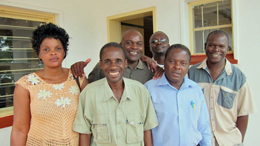 Development Aid from People to People (DAPP): Development Aid from People to People (DAPP) has developed a technical committee at the district level that includes the Ministry of Local Government and Housing, Ministry of Education, Department of Water Affairs and DAPP to plan WASH in school activities. Seen here is a technical team from images on Water, sanitation and hygiene in Zambian schools. Photograph courtesy of Jay Graham
Development Aid from People to People (DAPP): Development Aid from People to People (DAPP) has developed a technical committee at the district level that includes the Ministry of Local Government and Housing, Ministry of Education, Department of Water Affairs and DAPP to plan WASH in school activities. Seen here is a technical team from images on Water, sanitation and hygiene in Zambian schools. Photograph courtesy of Jay Graham
“If we are to continue moving forward,” Graham writes, all sectors of society will need to more fully engage; these include researchers, national and local governments, NGOs, the private sector, international and bilateral agencies, and communities.”
Progress on Drinking Water and Sanitation 2012 highlights the immense challenges that remain. Global figures mask massive disparities between regions and countries, and within countries.
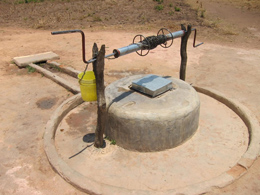 Windlass used to raise water from the well: from images on Water, sanitation and hygiene in Zambian schools. Photograph courtesy of Jay Graham
Windlass used to raise water from the well: from images on Water, sanitation and hygiene in Zambian schools. Photograph courtesy of Jay Graham
Only 61 per cent of the people in sub-Saharan Africa have access to improved water supply sources compared with 90 per cent or more in Latin America and the Caribbean, Northern Africa, and large parts of Asia.
Over 40 per cent of all people globally who lack access to drinking water live in sub-Saharan Africa.
The report confirms that in cases where water supplies are not readily accessible, the burden of carrying water falls disproportionately on women and girls.
In many countries, the wealthiest people have seen the greatest improvement in water and sanitation access, while the poorest still lag far behind.
The report provides the latest update on rural areas across the globe, highlighting the need for greater attention both to water and sanitation.
In rural areas in Least Developed Countries, 97 out of every 100 people do not have piped water and 14 per cent of the population drinks surface water—for example, from rivers, ponds, or lakes.
Of 1.1 billion people who still practice open defecation, the vast majority (949 million) live in rural areas.
This affects even regions with high levels of improved water access. For instance, 17 per cent of rural dwellers in Latin America and the Caribbean and 9 per cent in Northern Africa still resort to open defecation.
Even the so-called BRIC countries, with rapidly growing economies, have large numbers of people who practice open defecation: 626 million in India, 14 million in China, and 7.2 million in Brazil.
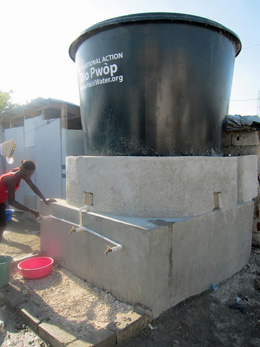 Haiti: Camp water system for internally displaced persons (IDP): Photograph courtesy of Jay Graham
Haiti: Camp water system for internally displaced persons (IDP): Photograph courtesy of Jay Graham
“We have reached an important target, but we cannot stop here,” the Secretary-General said.
“Our next step must be to target the most difficult to reach, the poorest and the most disadvantaged people across the world. The United Nations General Assembly has recognized drinking water and sanitation as human rights. That means we must ensure that every person has access.”
About the JMP
The WHO/UNICEF Joint Monitoring Programme for Water Supply and Sanitation (JMP) monitors progress towards the Millennium Development Goal (MDG) target to halve, by 2015, the proportion of people without sustainable access to safe drinking water and basic sanitation. The JMP publishes a report every two years which presents an update on the progress made towards reaching the MDG target for drinking water and sanitation using proxy indicators for use of improved drinking-water sources and the use of improved sanitation facilities.
The report and country data are available on the JMP website www.wssinfo.org and from WHO web-site at www.who.int/water_sanitation_health and UNICEF Statistics website: www.childinfo.org and www.unicef.org
Downloads
Download the publication (split into chapters)
Download the publication (full text)
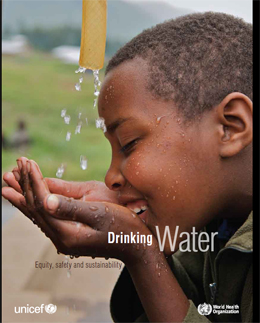 Drinking Water: Equity, Safety and Sustainability ReportThe JMP has released a new thematic report "Drinking Water: Equity, safety and sustainability". The report investigates access to and use of drinking water in greater detail than is possible in the regular JMP progress reports, and includes increased disaggregation of water service levels and analyses of trends across countries and regions. It focuses on the three key challenges of equity, safety and sustainability.
Drinking Water: Equity, Safety and Sustainability ReportThe JMP has released a new thematic report "Drinking Water: Equity, safety and sustainability". The report investigates access to and use of drinking water in greater detail than is possible in the regular JMP progress reports, and includes increased disaggregation of water service levels and analyses of trends across countries and regions. It focuses on the three key challenges of equity, safety and sustainability.
JMP Overview
The WHO/UNICEF Joint Monitoring Programme for Water Supply and Sanitation (JMP) reports every two years on progress towards the drinking-water and sanitation target under Millennium Development Goal 7. This target calls for halving the proportion of the population without sustainable access to safe drinking water and basic sanitation between 1990 and 2015. Estimates presented in its 2012 update report describe the situation at the end 2010 and supersede those of the JMP update published in March 2010.
The report brings welcome news: measured by the proxy-indicator consistently used by the JMP since 2000, the MDG drinking-water target was met in 2010, five years ahead of schedule. However, the job is far from done. An estimated 780 million still lacked safe drinking water in 2010, and the world is unlikely to meet the MDG sanitation target. A reduction in urban-rural disparities and inequities associated with poverty; drinking-water coverage in countries in sub-Saharan Africa and Oceania; putting sanitation ‘on track’; and universal coverage beyond 2015 all remain high on the development and public health agenda.
About WHO
The World Health Organization is the directing and coordinating authority for health within the United Nations system. It is responsible for providing leadership on global health matters, shaping the health research agenda, setting norms and standards, articulating evidence-based policy options, providing technical support to countries and monitoring and assessing health trends. From its inception, WHO has recognized the importance of water and sanitation.
About UNICEF
UNICEF works in 190 countries and territories to help children survive and thrive, from early childhood through adolescence. The world’s largest provider of vaccines for developing countries, UNICEF supports child health and nutrition, good water and sanitation, quality basic education for all boys and girls, and the protection of children from violence, exploitation, and AIDS. UNICEF is funded entirely by the voluntary contributions of individuals, businesses, foundations and governments. For more information about UNICEF and its work visit: www.unicef.org
This article includes news from UNICEF and WHO 6 March 2012
Lenny Kravitz supports UNICEF’s Water, Sanitation and Hygiene effort
Search
Latest articles
Agriculture
- World Water Week: Healthy ecosystems essential to human health: from coronavirus to malnutrition Online session Wednesday 24 August 17:00-18:20
- World Water Week: Healthy ecosystems essential to human health: from coronavirus to malnutrition Online session Wednesday 24 August 17:00-18:20
Air Pollution
- "Water and Sanitation-Related Diseases and the Changing Environment: Challenges, Interventions, and Preventive Measures" Volume 2 Is Now Available
- Global Innovation Exchange Co-Created by Horizon International, USAID, Bill and Melinda Gates Foundation and Others
Biodiversity
- It is time for international mobilization against climate change
- World Water Week: Healthy ecosystems essential to human health: from coronavirus to malnutrition Online session Wednesday 24 August 17:00-18:20
Desertification
- World Water Week: Healthy ecosystems essential to human health: from coronavirus to malnutrition Online session Wednesday 24 August 17:00-18:20
- UN Food Systems Summit Receives Over 1,200 Ideas to Help Meet Sustainable Development Goals
Endangered Species
- Mangrove Action Project Collaborates to Restore and Preserve Mangrove Ecosystems
- Coral Research in Palau offers a “Glimmer of Hope”
Energy
- Global Innovation Exchange Co-Created by Horizon International, USAID, Bill and Melinda Gates Foundation and Others
- Wildlife Preservation in Southeast Nova Scotia
Exhibits
- Global Innovation Exchange Co-Created by Horizon International, USAID, Bill and Melinda Gates Foundation and Others
- Coral Reefs
Forests
- NASA Satellites Reveal Major Shifts in Global Freshwater Updated June 2020
- Global Innovation Exchange Co-Created by Horizon International, USAID, Bill and Melinda Gates Foundation and Others
Global Climate Change
- It is time for international mobilization against climate change
- It is time for international mobilization against climate change
Global Health
- World Water Week: Healthy ecosystems essential to human health: from coronavirus to malnutrition Online session Wednesday 24 August 17:00-18:20
- More than 400 schoolgirls, family and teachers rescued from Afghanistan by small coalition
Industry
- "Water and Sanitation-Related Diseases and the Changing Environment: Challenges, Interventions, and Preventive Measures" Volume 2 Is Now Available
- Global Innovation Exchange Co-Created by Horizon International, USAID, Bill and Melinda Gates Foundation and Others
Natural Disaster Relief
- STOP ATTACKS ON HEALTH CARE IN UKRAINE
- Global Innovation Exchange Co-Created by Horizon International, USAID, Bill and Melinda Gates Foundation and Others
News and Special Reports
- World Water Week: Healthy ecosystems essential to human health: from coronavirus to malnutrition Online session Wednesday 24 August 17:00-18:20
- STOP ATTACKS ON HEALTH CARE IN UKRAINE
Oceans, Coral Reefs
- World Water Week: Healthy ecosystems essential to human health: from coronavirus to malnutrition Online session Wednesday 24 August 17:00-18:20
- Mangrove Action Project Collaborates to Restore and Preserve Mangrove Ecosystems
Pollution
- Zakaria Ouedraogo of Burkina Faso Produces Film “Nzoue Fiyen: Water Not Drinkable”
- "Water and Sanitation-Related Diseases and the Changing Environment: Challenges, Interventions, and Preventive Measures" Volume 2 Is Now Available
Population
- "Water and Sanitation-Related Diseases and the Changing Environment: Challenges, Interventions, and Preventive Measures" Volume 2 Is Now Available
- "Water and Sanitation-Related Diseases and the Changing Environment: Challenges, Interventions, and Preventive Measures" Volume 2 Is Now Available
Public Health
- Honouring the visionary behind India’s sanitation revolution
- Honouring the visionary behind India’s sanitation revolution
Rivers
- World Water Week: Healthy ecosystems essential to human health: from coronavirus to malnutrition Online session Wednesday 24 August 17:00-18:20
- Mangrove Action Project Collaborates to Restore and Preserve Mangrove Ecosystems
Sanitation
- Honouring the visionary behind India’s sanitation revolution
- Honouring the visionary behind India’s sanitation revolution
Toxic Chemicals
- "Water and Sanitation-Related Diseases and the Changing Environment: Challenges, Interventions, and Preventive Measures" Volume 2 Is Now Available
- Actions to Prevent Polluted Drinking Water in the United States
Transportation
- "Water and Sanitation-Related Diseases and the Changing Environment: Challenges, Interventions, and Preventive Measures" Volume 2 Is Now Available
- Urbanization Provides Opportunities for Transition to a Green Economy, Says New Report
Waste Management
- Honouring the visionary behind India’s sanitation revolution
- Honouring the visionary behind India’s sanitation revolution
Water
- Honouring the visionary behind India’s sanitation revolution
- Honouring the visionary behind India’s sanitation revolution
Water and Sanitation
- Honouring the visionary behind India’s sanitation revolution
- Honouring the visionary behind India’s sanitation revolution

